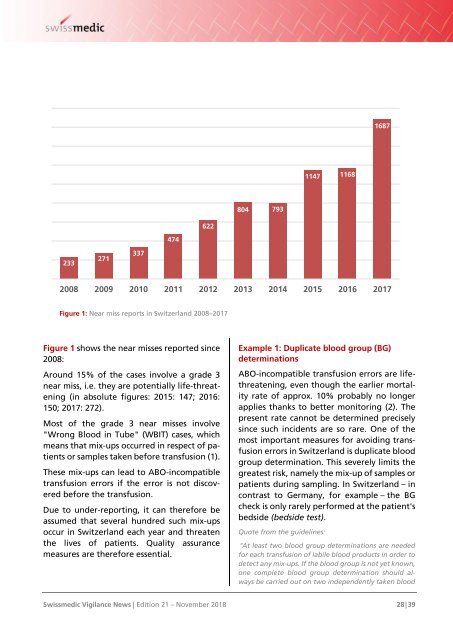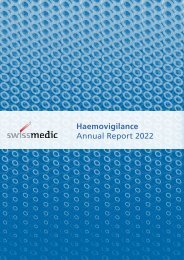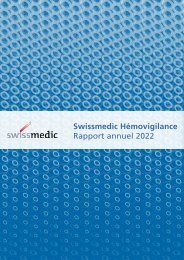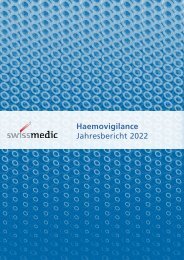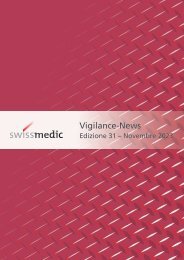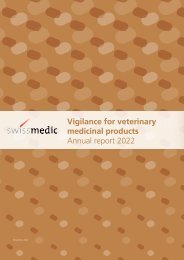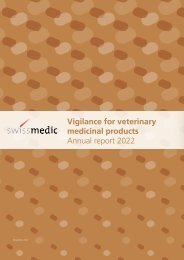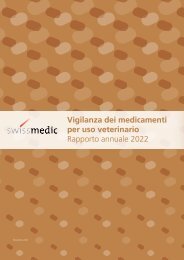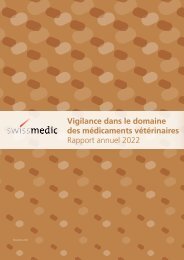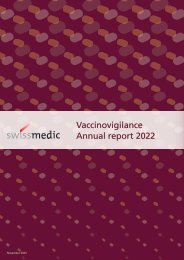Swissmedic Vigilance News Edition 21 – November 2018
In this edition: Isotretinoin and DOAC – Updates Confusion between amphotericin B formulations Guest articles: RPVC Zurich and RPVC Ticino Quality Assurance in Transfusion Practice Statistical Review 2017
In this edition:
Isotretinoin and DOAC – Updates
Confusion between amphotericin B formulations
Guest articles: RPVC Zurich and RPVC Ticino
Quality Assurance in Transfusion Practice
Statistical Review 2017
Create successful ePaper yourself
Turn your PDF publications into a flip-book with our unique Google optimized e-Paper software.
1687<br />
1147 1168<br />
804 793<br />
622<br />
474<br />
233<br />
271<br />
337<br />
2008 2009 2010 2011 2012 2013 2014 2015 2016 2017<br />
Figure 1: Near miss reports in Switzerland 2008<strong>–</strong>2017<br />
Figure 1 shows the near misses reported since<br />
2008:<br />
Around 15% of the cases involve a grade 3<br />
near miss, i.e. they are potentially life-threatening<br />
(in absolute figures: 2015: 147; 2016:<br />
150; 2017: 272).<br />
Most of the grade 3 near misses involve<br />
"Wrong Blood in Tube" (WBIT) cases, which<br />
means that mix-ups occurred in respect of patients<br />
or samples taken before transfusion (1).<br />
These mix-ups can lead to ABO-incompatible<br />
transfusion errors if the error is not discovered<br />
before the transfusion.<br />
Due to under-reporting, it can therefore be<br />
assumed that several hundred such mix-ups<br />
occur in Switzerland each year and threaten<br />
the lives of patients. Quality assurance<br />
measures are therefore essential.<br />
Example 1: Duplicate blood group (BG)<br />
determinations<br />
ABO-incompatible transfusion errors are lifethreatening,<br />
even though the earlier mortality<br />
rate of approx. 10% probably no longer<br />
applies thanks to better monitoring (2). The<br />
present rate cannot be determined precisely<br />
since such incidents are so rare. One of the<br />
most important measures for avoiding transfusion<br />
errors in Switzerland is duplicate blood<br />
group determination. This severely limits the<br />
greatest risk, namely the mix-up of samples or<br />
patients during sampling. In Switzerland <strong>–</strong> in<br />
contrast to Germany, for example <strong>–</strong> the BG<br />
check is only rarely performed at the patient's<br />
bedside (bedside test).<br />
Quote from the guidelines:<br />
"At least two blood group determinations are needed<br />
for each transfusion of labile blood products in order to<br />
detect any mix-ups. If the blood group is not yet known,<br />
one complete blood group determination should always<br />
be carried out on two independently taken blood<br />
<strong>Swissmedic</strong> <strong>Vigilance</strong> <strong>News</strong> | <strong>Edition</strong> <strong>21</strong> <strong>–</strong> <strong>November</strong> <strong>2018</strong> 28 | 39


